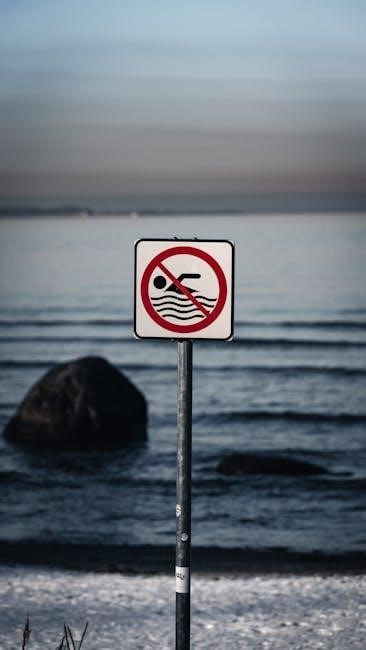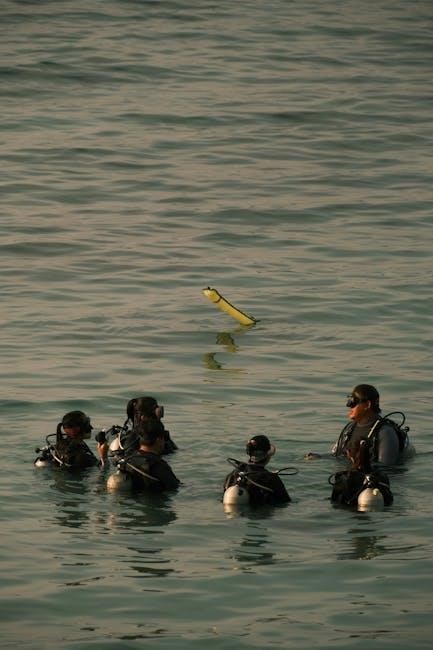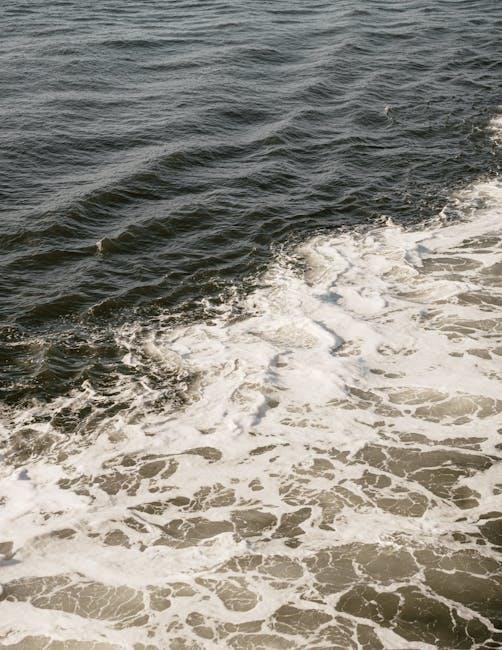
Overview of Collision Regulations at Sea
The International Regulations for Preventing Collisions at Sea (COLREGs) are a set of rules designed to ensure maritime safety. Established in 1972, they provide guidelines for vessel behavior to prevent collisions. These rules are mandatory for all ships and apply globally.
1.1 Importance of COLREGs in Maritime Safety
The International Regulations for Preventing Collisions at Sea (COLREGs) are fundamental to ensuring maritime safety worldwide. By establishing clear rules for vessel behavior, COLREGs significantly reduce the risk of collisions, protecting lives, cargo, and the environment. These regulations are universally adopted, providing a standardized framework for navigation that applies to all ships, regardless of their flag or operation.
COLREGs address critical aspects of maritime safety, such as safe speeds, overtaking procedures, and traffic separation schemes. They also provide guidelines for vessels operating in restricted visibility or under specific conditions. By adhering to these rules, mariners can minimize the likelihood of accidents and ensure efficient navigation in busy waterways.
The importance of COLREGs extends beyond collision prevention. They also contribute to the smooth functioning of global trade by maintaining order at sea. Compliance with these regulations is mandatory under international law, making them a cornerstone of modern maritime operations. Their universal application ensures consistency and predictability, which are essential for safe navigation in an increasingly busy maritime environment.
1.2 Key Objectives of the Regulations
The primary objective of the International Regulations for Preventing Collisions at Sea (COLREGs) is to promote maritime safety through standardized rules of navigation. By establishing clear guidelines for vessel conduct, COLREGs aim to prevent collisions and ensure the safe and efficient movement of ships worldwide.
Another key objective is to provide a universal framework that applies to all vessels, regardless of their type or size. This ensures consistency in navigation practices and reduces the risk of misunderstandings that could lead to accidents. COLREGs also emphasize the importance of maintaining a safe speed, especially in high-traffic areas or under adverse weather conditions.
Additionally, the regulations aim to protect the marine environment by minimizing the risk of collisions that could result in oil spills or other forms of pollution. By fostering cooperation among nations and ensuring compliance with international standards, COLREGs play a crucial role in maintaining global maritime safety and security.

History and Development of COLREGs
The International Regulations for Preventing Collisions at Sea (COLREGs) were established in 1972, replacing the 1960 Collision Regulations. Developed by the International Maritime Organization (IMO), they became effective in 1977. These rules have undergone updates to adapt to maritime safety needs and technological advancements over time.
2.1 Background and Evolution of the Regulations
The International Regulations for Preventing Collisions at Sea (COLREGs) were developed to address the growing need for standardized maritime safety rules. Originating from the 1960 Convention, these regulations were updated in 1972 to enhance safety measures. The evolution of COLREGs reflects advancements in navigation technology and increased global maritime traffic. Key amendments have been introduced to clarify rules, such as those related to traffic separation schemes and vessel maneuverability. These updates ensure that COLREGs remain relevant and effective in preventing collisions at sea, promoting safer navigation practices worldwide.
2.2 Major Amendments and Updates
Significant amendments to the COLREGs have been made to adapt to technological advancements and operational needs. In 1981, updates clarified rules for vessels using radar and improved standards for navigation lights. The 1995 amendments introduced stricter requirements for vessel traffic services and enhanced safety in busy shipping lanes. Further updates in 2003 focused on reducing ambiguities in existing rules, such as those related to overtaking and crossing situations. These changes ensure COLREGs remain effective in modern maritime environments, addressing challenges like increased vessel traffic and autonomous shipping technologies.
Key Principles of COLREGs
The COLREGs establish fundamental principles for safe navigation, including the “give-way” and “stand-on” rules, safe speed, and traffic separation schemes. These principles ensure clarity and consistency in vessel behavior, minimizing collision risks at sea.
3.1 General Definitions and Terminology
The COLREGs begin by defining key terms essential for understanding the rules. A power-driven vessel is one propelled by machinery, while a sailing vessel relies on wind. Overtaking occurs when a vessel catches up to another. Give-way vessels must act to avoid collision, while stand-on vessels maintain course. Restricted maneuverability applies to vessels with limited ability to change direction. These definitions ensure clarity in applying the rules, promoting consistent behavior across all mariners. Proper understanding of these terms is critical for safe navigation and compliance with the regulations.
3.2 Rules for Vessels in Sight of One Another
When vessels are in sight of one another, COLREGs establish clear guidelines to prevent collisions. Under Rule 5, every vessel must maintain a proper lookout using sight, hearing, and all available means. This ensures early detection of potential risks. Rule 7 requires vessels to assess the risk of collision and take appropriate action. If a collision risk exists, Rule 8 mandates that actions be taken in accordance with the rules, avoiding abrupt maneuvers that could worsen the situation.
Key principles include determining whether a vessel is on a collision course and taking early, visible action to avoid it. Vessels must not alter course in a way that could confuse others. These rules apply universally, whether in open waters or traffic separation schemes, ensuring predictable behavior and reducing collision risks. By adhering to these guidelines, mariners can navigate safely and responsibly, minimizing the likelihood of incidents at sea.
3.3 Specific Rules for Different Types of Vessels
COLREGs provide distinct guidelines for various types of vessels to ensure safe navigation. Power-driven vessels, defined as those propelled by machinery, must give way to sailing vessels under Rule 14. However, this rule does not apply if the sailing vessel is overtaking. Sailing vessels, on the other hand, must avoid impeding the safe passage of power-driven vessels, as outlined in Rule 13. Additionally, fishing vessels are required to display specific lights and shapes to signal their activities to other mariners, ensuring visibility and awareness.
Fishing vessels must also operate with caution, especially when engaged in trawling or purse seining, to avoid collisions. Vessels with restricted maneuverability, such as those engaged in towing operations or dredging, are granted exemptions from certain rules under specific conditions. These tailored regulations ensure that all vessels, regardless of their operational requirements, can navigate safely and efficiently while adhering to COLREGs.
3.4 Special Considerations for Traffic Separation Schemes
Traffic separation schemes (TSS) are critical for organizing maritime traffic in busy shipping lanes to reduce collision risks. Under COLREG Rule 10, vessels must adhere to specific guidelines when operating within or near these schemes. The rule mandates that ships stay within designated lanes and refrain from crossing traffic lanes unless absolutely necessary. Vessels must also avoid navigating in a manner that disrupts the flow of traffic within the scheme.

Rule 10 emphasizes that ships entering or exiting a TSS must do so at the designated points, ensuring safe passage without endangering other vessels. Additionally, vessels must comply with all applicable COLREG rules while navigating within these schemes, including rules related to speed, lookout, and maneuvering. The International Maritime Organization (IMO) coordinates the establishment of TSS globally, ensuring consistency and safety in high-traffic areas.
These schemes are particularly effective in reducing collisions in congested waterways, such as straits and busy ports. By separating opposing streams of traffic and providing clear navigation guidelines, TSS significantly enhance maritime safety. Compliance with Rule 10 is essential for maintaining the integrity of these systems and ensuring the safety of all vessels involved. Rule 8, which allows for deviations from the rules to avoid immediate danger, also applies in TSS, but such actions must be taken with extreme caution to avoid disrupting the orderly flow of traffic.
Overall, traffic separation schemes play a vital role in preventing collisions at sea, and adherence to the associated COLREG rules is paramount for safe navigation. These measures are continuously updated to address evolving maritime challenges and ensure the highest level of safety in international waters.

Rules for Avoiding Collisions
COLREGs provide clear guidelines for preventing collisions, emphasizing safe speed, proper lookout, and maneuvering. Rules address head-on, crossing, and overtaking situations, ensuring predictable vessel behavior and minimizing collision risks at sea.
4.1 Head-On Situations and Rule 14
Rule 14 of the COLREGs specifically addresses head-on situations between two power-driven vessels. When such a risk of collision exists, each vessel must alter its course to starboard, ensuring a safe passage without turning towards each other. This rule emphasizes the importance of predictable and coordinated actions to avoid collision. Proper compliance with Rule 14 is essential for maintaining maritime safety and preventing accidents in such scenarios. Vessels must take immediate and noticeable action to divert from their original paths, thereby reducing the risk of a head-on collision. The rule also underscores the need for clear communication and mutual understanding between vessels to ensure effective maneuvering. By adhering to Rule 14, mariners can significantly enhance safety at sea, particularly in busy shipping lanes where head-on encounters are more common. This rule is a cornerstone of collision prevention strategies and is widely recognized as a critical component of safe navigation practices.
4.2 Crossing Situations and Rule 15
Rule 15 of the COLREGs governs crossing situations at sea, providing clear guidelines to prevent collisions when two vessels are on reciprocal courses. The rule establishes that if a vessel has another on its starboard side, it must keep out of the way (give-way vessel), while the vessel on the port side (stand-on vessel) must maintain its course and speed. This ensures predictable behavior and reduces collision risks.
The give-way vessel is required to take early and substantial action to avoid collision, preferably altering its course to starboard. The stand-on vessel, however, must not deviate from its path, as sudden changes could exacerbate the situation. Exceptions apply, such as when the give-way vessel is a sailing ship or when the stand-on vessel is hampered by restricted maneuverability.
Rule 15 emphasizes the importance of safe passing distances and the need for both vessels to monitor each other’s movements. Proper compliance ensures orderly navigation and minimizes the risk of accidents in crossing scenarios. This rule is fundamental to maintaining maritime safety and is widely adhered to by mariners globally.
4.3 Overtaking Situations and Rule 13
Rule 13 of the COLREGs addresses overtaking situations, outlining the responsibilities of both the overtaking vessel and the vessel being overtaken. An overtaking situation occurs when a vessel intends to pass another vessel that is ahead and moving in the same direction. The overtaking vessel is considered the “give-way” vessel and must take necessary actions to safely overtake without impeding the progress of the vessel being overtaken.
The overtaking vessel must ensure that the maneuver can be completed safely, taking into account factors such as visibility, traffic density, and the speed of both vessels. It should not assume that the overtaken vessel will take evasive action. The vessel being overtaken, in turn, must maintain its course and speed to avoid complicating the situation. Rule 13 also applies to any vessel that is being overtaken, regardless of its type or size.
Exceptions include cases where the overtaken vessel is a sailing ship or has restricted maneuverability, which may require additional precautions. Compliance with Rule 13 ensures safe and orderly navigation, preventing collisions during overtaking maneuvers. Adhering to these guidelines is essential for maintaining maritime safety and avoiding potential hazards at sea.
4.4 Safe Speed and Rule 6
Rule 6 of the COLREGs emphasizes the importance of safe speed in maritime navigation to prevent collisions. Safe speed is defined as the speed that allows a vessel to take effective action to avoid a collision in ample time, considering factors such as visibility, traffic density, and weather conditions.
Every vessel must proceed at a speed that allows it to stop or maneuver within the available space and time. Factors influencing safe speed include the state of visibility (e.g., fog, darkness), proximity to other vessels, and the operational limitations of the ship. Vessels must be able to respond promptly to any potential collision risk, ensuring they can alter course or reduce speed effectively.
Rule 6 also requires vessels to take into account their maneuvering characteristics, such as stopping distance and turning radius. Additionally, the rule applies to all types of vessels, including power-driven, sailing, and fishing vessels. Compliance with Rule 6 ensures that vessels operate in a manner that minimizes collision risks, promoting overall maritime safety.
Vessel-Specific Regulations
COLREGs provide specific rules for different types of vessels, ensuring safe navigation. Power-driven, sailing, fishing, and vessels with restricted maneuverability each have tailored regulations. These rules address unique operational needs and limitations, promoting collision avoidance and maritime safety for all vessel categories globally.
5.1 Rules for Power-Driven Vessels
Power-driven vessels, defined as those propelled by machinery, must adhere to specific COLREGs to ensure safe navigation. These rules govern the use of navigation lights, shapes, and sound signals to communicate intentions and status to other vessels. For instance, power-driven vessels are required to display a masthead light forward, a stern light aft, and sidelights on both sides to indicate their direction and speed. These visual signals help other vessels determine their relative position and movement.
Additionally, power-driven vessels must exercise particular caution in overtaking situations. When overtaking another vessel, the overtaking vessel is responsible for ensuring safe passage, while the vessel being overtaken must maintain its course and speed unless instructed otherwise. These rules are designed to minimize the risk of collision by establishing clear responsibilities and communication protocols. Compliance with these regulations is essential for maintaining maritime safety and preventing accidents at sea.
5.2 Rules for Sailing Vessels
Sailing vessels, which rely on wind for propulsion, are subject to specific COLREGs to ensure their safe operation at sea. These rules address the unique challenges faced by sailing vessels, particularly in situations where they may not have the same maneuverability as power-driven vessels. Sailing vessels are required to display distinctive shapes and lights to signal their status to other vessels. For example, a sailing vessel underway must exhibit a conical shape (pointing downward) on the mast. When sailing vessels are under power, they must display the same lights as power-driven vessels, indicating their dual capability.
In situations where a sailing vessel is constrained by its ability to maneuver due to wind and sea conditions, it is entitled to special consideration. However, this does not absolve the vessel of its responsibility to take all possible precautions to avoid collision. COLREGs also emphasize the importance of mutual vigilance between sailing vessels and power-driven vessels, ensuring that both types of vessels take necessary actions to prevent accidents. These rules are designed to promote harmony and safety among all types of vessels sharing the maritime environment.
5.3 Rules for Fishing Vessels
Fishing vessels are subject to specific regulations under COLREGs to ensure their safe operation and minimize collision risks. These rules address the unique challenges faced by fishing vessels, particularly when engaged in fishing operations or towing gear. Fishing vessels are required to display distinctive shapes and lights to indicate their activities to other vessels. For example, a fishing vessel engaged in fishing must exhibit a green light on the starboard side and a red light on the port side, along with a masthead light. Additionally, fishing vessels must use radar and other navigational aids to enhance situational awareness.

When fishing vessels are operating in close proximity to other vessels, COLREGs mandate that they take extra precautions to avoid collisions. This includes maintaining a safe distance from other vessels and being prepared to take evasive action if necessary. Fishing vessels are also required to communicate effectively with nearby vessels using standardized signals. Furthermore, COLREGs emphasize the importance of mutual vigilance between fishing vessels and other maritime traffic, ensuring that all parties take responsibility for collision avoidance.
5.4 Rules for Vessels with Restricted Maneuverability
Vessels with restricted maneuverability, such as those engaged in towing, dredging, or underwater operations, are subject to specific COLREGs to ensure their safety and the safety of other vessels. These rules recognize the limitations of such vessels and provide clear guidelines for their operation. Vessels with restricted maneuverability must display appropriate signals, such as a black cylinder shape during daylight hours and specific lights at night, to indicate their status to other mariners.
Other vessels are required to exercise extreme caution when encountering a vessel with restricted maneuverability. They must take early and substantial action to avoid a collision, as the restricted vessel may not be able to alter its course or speed effectively. Additionally, these rules emphasize the importance of maintaining a safe distance and using radar and other navigational aids to monitor the movement of nearby vessels. The COLREGs also stress the need for clear communication between vessels to prevent misunderstandings and enhance situational awareness.
Overall, the rules for vessels with restricted maneuverability are designed to balance their operational needs with the safety of all vessels at sea. By adhering to these guidelines, mariners can minimize collision risks and ensure safe navigation in shared waterways.